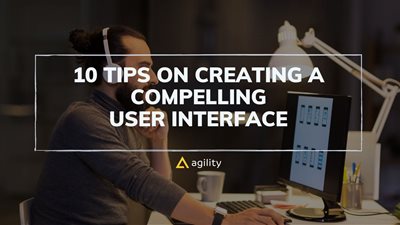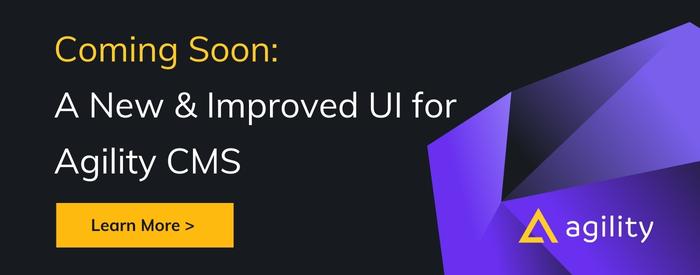10 Tips on Creating a Compelling User Interface
There are multiple strategies for making a compelling user interface – however, it should also be kept in mind that it should also have functionality.

A website is more than just a series of linked pages. It's an interface i.e. a place where a user's and a firm's digital presence interact, connect, and have an impact on one another. That encounter produces an experience for the visitors, and as a web designer, it is your job to make that interaction the best. There are multiple strategies and techniques for making an attractive and compelling user interface – however, it should also be kept in mind that alongside being good-looking, it should also have functionality.
What is a user interface and why is it important?

A website's user interface (UI) is the most crucial component. The layout for websites, software, or applications is referred to as a user interface. It's all about programming the appearance of different elements in order to make them more usable and enhance the user experience. In easier words, it is the set of elements on software or system that allow users to engage with it. Through contrasting graphics, clean look, and interactivity, a well-executed user interface promotes successful interaction between the user and the device, application, or program.
Types of user interfaces
- Voice-controlled interfaces (VUIs): Users communicate with them by using their voices. The majority of smart assistants, such as Siri on iPhones and Alexa on Amazon devices, are a perfect examples of VUIs.Graphical user interfaces
- (GUIs): On digital control panels, users interact with visual images. The desktop of a computer is a GUI.
- Gesture-based interfaces: Users interact with 3D design settings by moving their bodies, just like in virtual reality games.
How UI and UX Work Together
Because of its inclination to focus on the graphics of a product, user interface design is frequently recognized as a separate type of design from the user experience (UX). User interface design is an important part of the greater UX design approach. To generate the visual design deliverables, the user interface takes into account the insights and findings acquired from user surveys and interviews. User interface designers focus on developing the visual design language that will be utilized throughout, including colors, fonts, and symbols. User interface designers are also in charge of designing the practical elements that users interact with, such as text fields and buttons, which all contribute to making the product actually useful and improving the UX.
So, what makes a good user interface design?
Is it a matter of preference when it comes to color, style, or which component to employ over another? To assist you to understand what it takes to develop strong user interface design, we've compiled a list of points to help you improve your user interface design skills.
Know your users and how they interact with a product
A good-looking user interface with no explicit goal isn't likely to be very helpful. The glue that keeps the product together is designed for a particular person or for a specific purpose. Make sure you have a good grasp of your audience, their objectives, and when or how they will use your service.
You must have gathered data through surveys, preliminary discussions along with other relevant research to figure out how the product should work and how consumers can engage with it. Study your research carefully before you jump into designing.
Make reversible choices for Great UX
This implies that users should be able to reverse their actions. This lets customers experiment with the products without a sense of failure – knowing that mistakes can be readily reversed encourages users to try out new things.
Text and graphics editors are perhaps the most frequent GUIs with an 'Undo/Redo feature. 'Undo' allows users to make adjustments and go back through them step by step whether writing text or producing visuals. ‘Users can undo the undoing with 'Redo,' which allows them to go back a few steps and then move forward through their changes again.
When users choose system functions by accident, 'Undo' can be quite useful. In this circumstance, the undo function acts as an 'emergency escape,' allowing people to get out of an undesirable situation. For example, Gmail’s undo option has proved to be very handy and saves many of us!
Consider the size and position of elements

Fitts’ Law, a fundamental principle of human-computer interaction (HCI), states that:
The time to acquire a target is a function of the distance to and size of the target, according to Fitts' Law, a key principle of human-computer interaction (HCI).
To put it another way, the nearer or larger there's something, the quicker your cursor can be placed on it. This has a variety of implications for interaction and user interface design strategies, but three of the most significant are as follows:
- Make buttons and other clickable (such as symbols and hypertexts) visible and clickable. This is especially crucial when it comes to fonts, navigation, and other link lists since a lack of space will lead to visitors repeatedly hitting the erroneous links.
- Increase the size and prominence of the buttons for the most common actions.
- Place menu along with other popular interactive graphic components such as search bars on the screen's edges or corners. This last strategy may appear paradoxical, but it works because it reduces the need for precision: a user won't have to worry about missing their click target.
Always keep your interaction model in mind while thinking about element placement and size. If your site demands vertical scrolling rather than horizontal scrolling, you'll need to think about where and how you'll alert consumers to this new sort of interaction.
Design a navigation system that is both efficient and simple to use
While it may seem obvious, it's easy to overlook the need of ensuring that your user interface design has specifically articulated navigational patterns throughout the website. Consider whether users can identify where they will be, where they came from, and where they might go on each page while creating each screen. It's also critical to ensure that your upper edge navigation properly identifies the part in which the user is currently located. Users can use these navigation patterns as guides to help them find their way around a product. Users can easily become confused and irritated without a proper guide. They frequently overlook important pages and resources, instead of pondering how they got there in the first place.
Support users with various skill levels with a well designed ui
A user interface design should allow users of various skill levels to engage with it at various levels. Professional users should not be sacrificed in favor of a user interface that is simple to use for beginner or regular users. Instead, plan to create for a wide range of users' demands, regardless of whether your user is an experienced or a beginner.
For beginner users, including elements like tutorials and descriptions are tremendously beneficial. However, make sure they can skip it if they want. Users who are familiar with a product will hunt for alternatives to speed up frequently performed tasks. Experienced users should be able to take faster routes by allowing them to employ shortcuts.
Decision-making should be easier
Sometimes banners spread to become full-screen advertisements. Pop-ups appear, pleading with us to subscribe to blogs we haven't had time to read yet. Video ads halt our progress, causing us to watch the valuable seconds tick away slowly.
The idea’s as basic as its final result: the more user interface options you give a user, the tougher it becomes for them to make a decision.
This has an influence on practically anything you construct:
- General designs
- Menus for navigating
- Pages dedicated to pricing
- Blog directories
The list could go on and on. But the bottom line is that the simpler our designs are, the quicker and simpler it is for consumers to make the decisions we want. That's why non-newsletter emails and landing pages should only have one call to action.
Make use of analogies from everyday life
Users can establish a comparison between the real world and digital experiences by using analogies in user interface design. Users are empowered by real-world analogies because they may apply current information about how things ought to appear and perform. Analogies are frequently employed to familiarize the unknown. Take, for example, the recycling bin on your desktop, which holds deleted files — it's not an actual trash can, but it's visually portrayed in a way that makes the concept easier to grasp.
From the perspective of users, effective analogies create a strong link to previous real-life experiences. When picking a user interface analogy, choose one that will allow users to understand the concept in a finer manner.
Expectations should be set
Numerous interactions with an application or website have repercussions, for example, pressing a button can result in you purchasing something accidentally. And wherever there are ramifications, concerns are raised. As a result, make sure users know what is expected if they press a button before they even do
You can use various design elements to set expectations
- Choose the button that corresponds to the desired action and highlight it
- Combine a commonly recognized symbol like a trash can for a delete button, a plus sign for adding something, or a magnifying glass for searching.
- Choosing a hue that has a specific meaning for example green could mean go, whereas red could refer to stop. It makes sense to ask individuals if they're sure about acts with irreversible repercussions, such as permanently removing something in red.
Use a "less is more" strategy for Graphic Design
One of the most critical user interface design lessons to be learned early on is to avoid overdesigning or providing consumers with too many choices or content all at once. When developing a product's interface, it's tempting to let your innovative thinking flow wild, but displaying too much on display can lead to inefficiency and leave consumers unsure of what to concentrate on or what steps need to be taken.
There's a classic experiment that investigates the concept of "choice paralysis," in which subjects are provided with 26 jam alternatives in one circumstance and just 6 possibilities in the other. Even though it was believed that when given numerous options, individuals would be more likely to buy a jar of jam, the experiment revealed that when given fewer choices, people were more likely to buy jam. Essentially, the experiment discovered that when we are given too many options, it is more difficult for us to be pleased with the best decision.
This concentration on minimalism is still at the heart of many successful designs, and the same idea applies to user interface designs. Aim for minimalism with each screen you create, and ensure that the information offered is useful to consumers rather than overpowering.
Use a headless CMS
Conventional CMS infrastructures must invest time and money in content editing and visualization. Because it does not have to handle the graphical side of things, a headless CMS provides benefits over conventional solutions. That's something you'll have to leave to the more specialist elements of your architecture.
Furthermore, because headless material isn't bound by a particular presentation concern (such as a website), it can reach a wide range of audiences. A headless CMS can be used to maintain content for websites and apps. You can even handle all of your internal/admin content in one spot and get more value out of it.
Bottom line
The goal for today's user interface designers is to create consumer-friendly interfaces, which stimulate discovery without fear of unwanted consequences. Without a question, futuristic interfaces will be more straightforward, attractive, reliable, and accommodating, but most of the user interface design ideas stated in this article will undoubtedly apply to them as well. Hopefully, you've learned a few new skills that you can apply to your interface. Using them efficiently, as always, requires patience and careful execution. Moreover, you can also take up some useful designing courses that will enhance your skills, knowledge, and expertise in drafting an excellent user interface. There are also a lot of tech skills that you can learn and take advantage of while drafting your interface. Explore, learn and make the best out of these pieces of advice.
About the Author
Ammara Tariq is a Marketing Manager at Chanty , a collaborative team chat, with a plan to take her team to new heights. With an everlasting love for marketing tactics, she’s also very fond of research writing and hopes to spread delight and knowledge to her readers
View Related Resources

User-Generated Content Strategy with a CMS To Drive Sales

Jamstack Pioneers You Need To Know About in 2022



